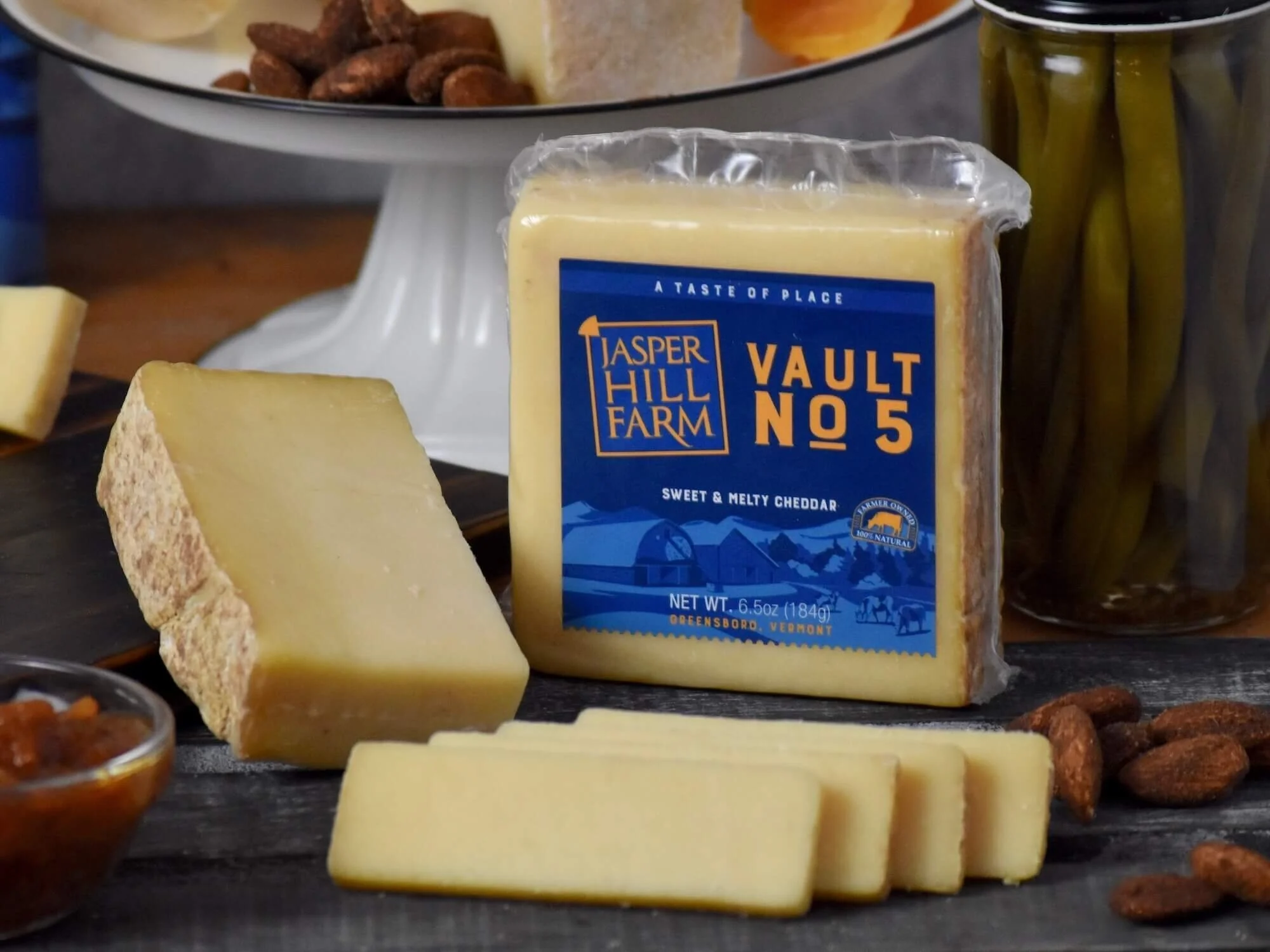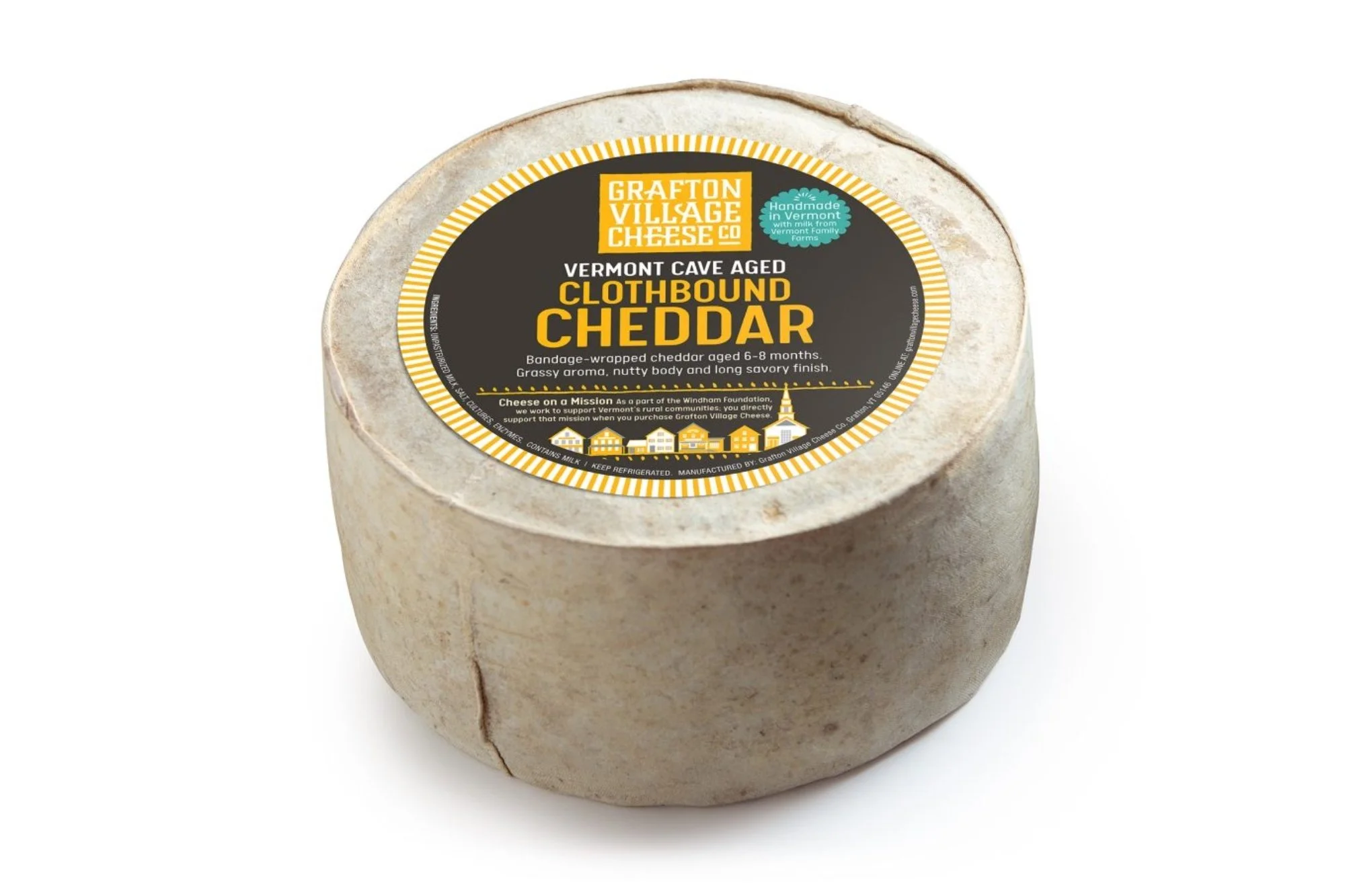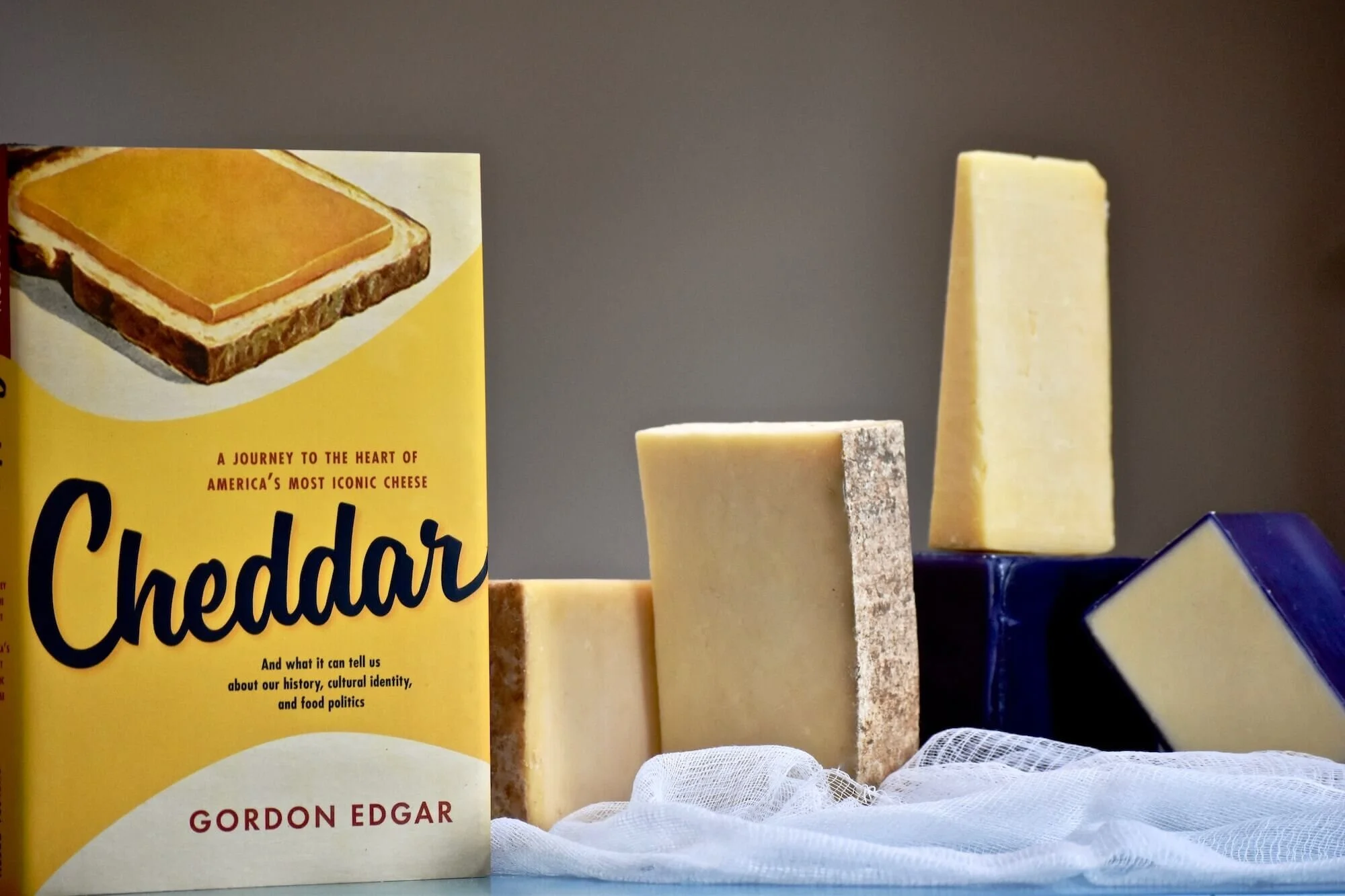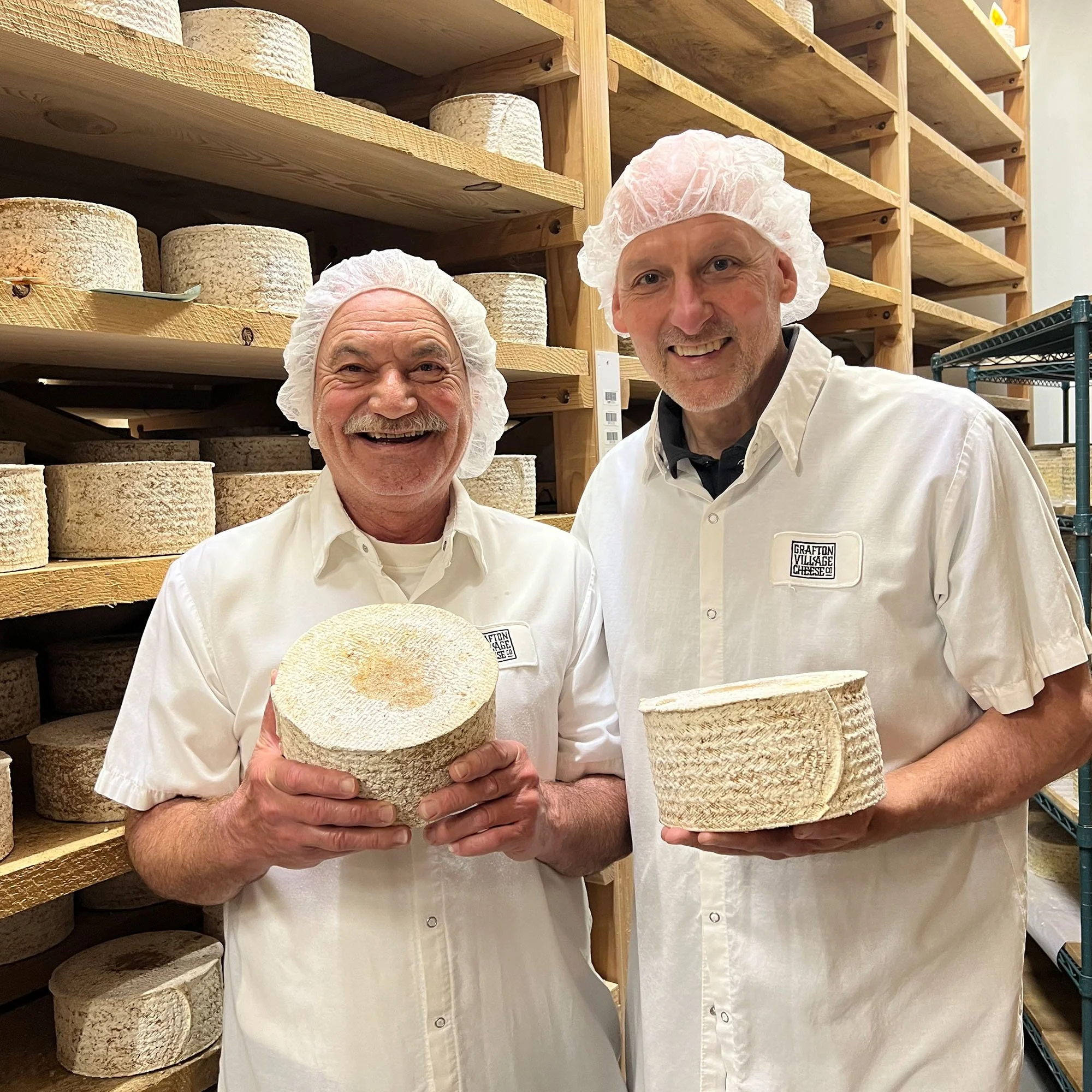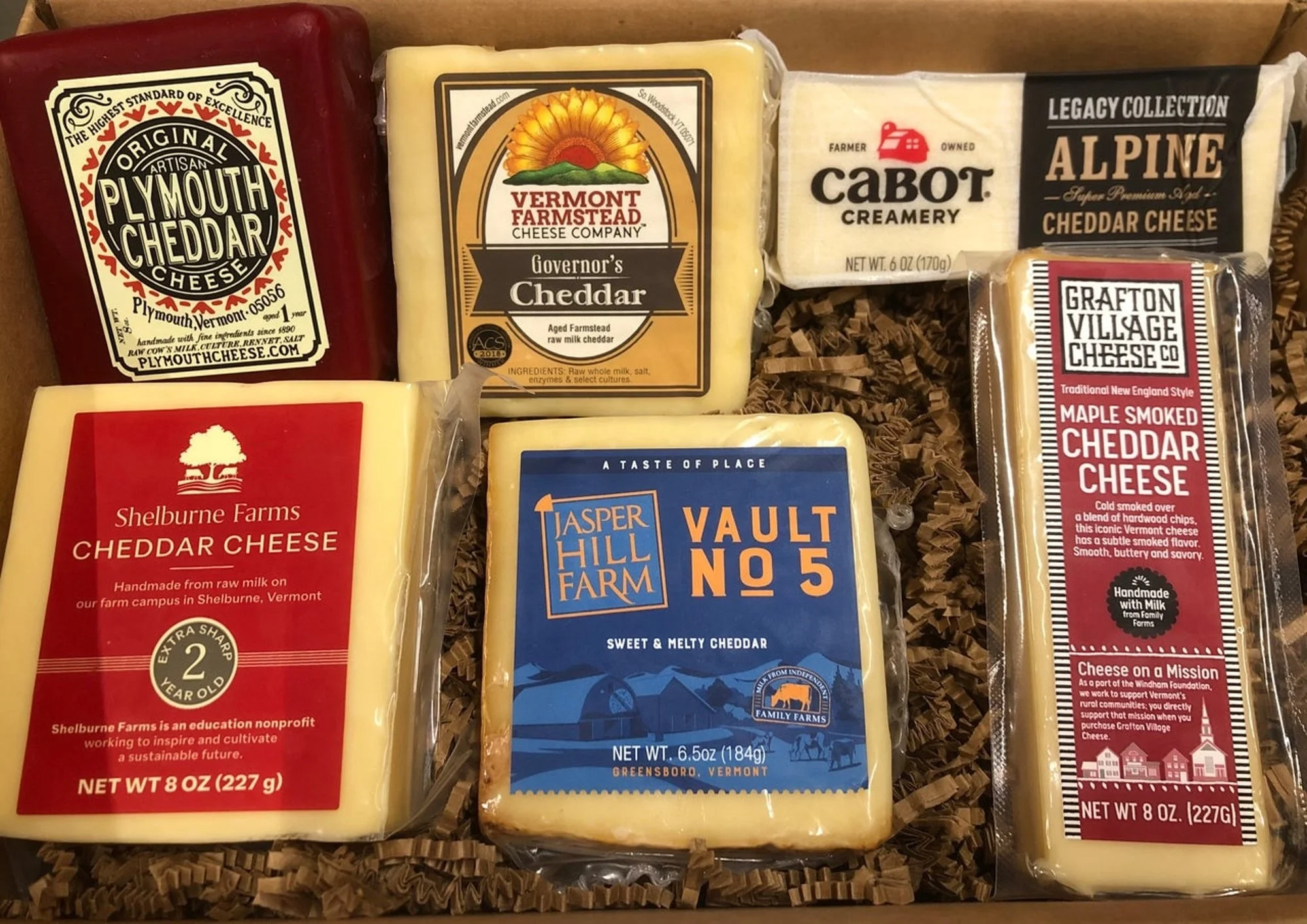What’s the Deal with Vermont Cheddar?
Jasper Hill Farm Vault 5 cheddar
Vermont is famous for Cheddar. But is there a Vermont style of Cheddar? If not, what is that makes Vermont Cheddar special? A few years ago, a group of five Vermont cheesemakers launched The Vermont Cheddar Project, a collaborative initiative intended to promote awareness of the variety of Cheddar cheeses crafted by the state’s cheese artisans. Through the project, consumers nationwide were able to purchase a collection of cheeses from six of those makers. In addition, a short video spotlighting the participating cheese companies was produced and links to the film were posted on company websites.
Different Makers, Different Cheddars
Grafton Village Vermont Cave Aged Clothbound Cheddar
Both the makers and their cheeses are equally varied—Cabot Creamery is a large farm cooperative with four facilities producing traditional and flavored cheddars available coast-to-coast, while Shelburne Farms specializes in traditional Vermont block cheddar made from the raw milk of its own herd.
In April 2025, Vermont Farmstead Cheese Co. announced its acquisition of Grafton Village Cheese Company, a move that could result in even more Vermont Cheddar reaching consumers in regions outside of New England. That news inspired us to take a closer look at Vermont’s Cheddars, and how they may differ from those made elsewhere in the U.S.
“The state is certainly recognized as a Cheddar state,” says author and educator Jeffery Roberts. “But some the best goat cheeses are also coming out of Vermont.” Indeed, Vermont is a dairy state first and foremost. The broader dairy industry represents about 76% of Vermont’s total agricultural economy. Cheese makes up just over half of that at approximately $650 million in annual sales, and Cheddar is likely to make up at least half of that. For cheese lovers, however, the quality of the state’s Cheddar is more important than the quantity. And many would say that the characteristics of Vermont’s standard, aged block Cheddar make it unique compared to others'—that the term Vermont Cheddar means more than just “Cheddar from Vermont.” So, is it something akin to New York pizza, or North Carolina barbecue? Can we talk about Cheddar terroir? Perhaps. Experts agree that setting aside flavored cheeses flavored with maple, and those made with special cultures, standard Vermont Cheddar has a unique aroma/flavor profile.
Vermont Terroir and Vermont Bite
Cheddar by Gordon Edgar
In researching his 2017 book Cheddar, A Journey to the Heart of America’s Most Iconic Cheese, cheesemonger/author Gordon Edgar found evidence for that argument, and wrote about it in reference to the cheeses from Grafton.“If terroir means ‘sense of place,’ then Vermont Cheddar gives you that more than any other Cheddar, and Grafton more than any other block Cheddar-maker,” Edgar wrote in a chapter called Vermont is not Wisconsin.
Both Roberts and Edgar note that Vermont has a lengthy tradition of using raw milk to make its Cheddar (many Vermont artisans still do) and that the use of raw milk might be one of the keys to the flavor and aroma notes in the cheeses.
While Cheddar made in Vermont often looks different (usually white or pale yellow without the use of flavorless annatto extract), more importantly, it tastes different. Sweet, milky flavor notes take a secondary role to a more noticeable sulfuric aroma and biting, (sometimes bitter) flavor compared with those Cheddars made elsewhere. “Vermonters are proud of their sulfery and bitter-sharp cheeses, and …. I think they appreciate making a Cheddar that says to a customer ‘I dare you to try this,’” Edgar notes in his book. He makes a point of using the upper case “Vermont Bite,” to describe that aroma and flavor profile that his customers either love or hate.
The Source of Vermont Bite
Mariano Gonzalez and Curt Alpeter
So where do those savory notes and sulfuric aromas come from? Mariano Gonzalez, head cheesemaker at Grafton Village Cheese, is a Cheddar veteran, having worked for Grafton, Shelburne, and California’s Fiscalini Cheese Company. Gonzalez agrees that there might be some terroir at work.
“The breed of the animals being milked, their management (whether they are out on pasture or not), the native forage, altitude, climate, etc., all affect the overall components and flavor of the milk,” he says. “I believe that the uniqueness of the grasses and mixed ration the cows are fed, contribute to the Vermont’s bite, a sharp flavor development with a hint of sulfur that gives it a very unique taste here in Vermont.”
Tom Perry of Shelburne Farms
Tom Perry, cheese sales manager at Shelburne, says there is something more specific that could be involved, and it has to do with something that took place underground millions of years ago.“I don’t know if Vermont Cheddar is more savory, in terms of umami, but it definitely has got sulfuric compounds that come through in the aroma,” Perry says. “Especially in milk from the Champlain valley, but it’s all over Vermont.”
Another thing that’s all over the Champlain valley is Iberville Shale, a rock created around 500 million years ago. That shale still carries white streaks of calcium carbonate, which leaches the mineral calcite into the Vermont soil. Soil to grasses, to milk, to cheese, the argument can be made. “That calcite is all through the soil, and so it is passed through to the flora—all the grasses and plants that the cows eat, and then into their milk,” Perry says, adding that similar characteristics may be found in neighboring New York and Canadian cheeses. Roberts is more skeptical, saying that the soil and feed are different in different parts of Vermont, and that there are many variables from one maker to the next. He believes that the long tradition of using fresh raw milk is still echoed in Vermont Cheddars made from pasteurized milk, due to learned techniques.
Another explanation Perry hints at has more to do with the control group that helps make the Vermont Bite more noticeable—Wisconsin Cheddars, and those made elsewhere whose flavors tend to follow the Wisconsin model.“I think the soil probably does have a lot to do with the different flavors from the East Coast compared to Wisconsin cheddar,” says Joey Widmer, vice president of operations at Wisconsin’s Widmer Cheese Cellars. Use of different cultures and aging techniques also come into play, Widmer says, but another factor might lie in a Wisconsin cheesemaking methodology.
“Many Wisconsin Cheddar producers will wash the Cheddar curds prior to salting which reduces the lactose and lactic acid levels, resulting in a sweeter and less acidic cheese,” Widmer says, adding that it is part of the process for Widmer’s outstanding Cheddars. “Not sure if that is as common a practice on East Coast Cheddar.”
Perry says that curd washing, one of the keys to the sweet/salty flavors of goudas, is not part of Vermont Cheddar making.
Mystery solved? Perhaps not. But I will stick with my assertion that there are now four types of Cheddar readily available in the U.S., with the other two being mixed culture cheeses, and clothbound cheddars from the UK and from North American artisans.
Meanwhile, with the April 2025 announcement of the Grafton acquisition, Vermont Farmstead CEO Kent Underwood pledged that both brands will be maintained, and both production facilities will continue operating. Twenty-one of 26 employees from Grafton are expected to join the combined company, and the goal will be to grow sales of both lines with customers beyond Vermont. “If they had Vermont Farmstead line, now they can add one or two Grafton products more easily,” he says. “And if you look at the top 10 customers, we only overlap on four.” Vermont Farmstead recently began selling cheese to the Midwest-based Hy-Vee supermarket chain. Underwood hopes that the deal will help keep Vermont cheddar and its Vermont Bite important parts of the state’s cheesemaking heritage.
“In our growth, and in the acquiring Grafton, that is at the forefront, and we are proud to be carrying that forward.”
Recommended Vermont Cheddars
Vermont Cheddars
The Vermont Cheese Project packages iconic Vermont Cheddars in one box, but you can purchase any of the following Vermont Cheddars to create your own tasting. Widmer’s Two Year Old Cheddar is a fine Wisconsin Cheddar for comparison.
Cabot Clothbound (aged by the Cellars of Jasper Hill)
Governor’s Cheddar (Vermont Farmstead)
Bismark II (Grafton with C.Hesse Cheese)
Vault No. 5 (Jasper Hill Creamery)
Legacy Collection (Cabot)
Hunter (Plymouth Artisan Cheese)

